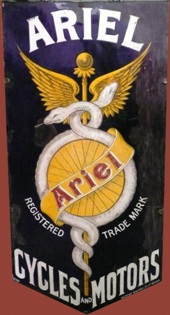THE EARLY YEARS (1901-1925) |
| 1901-1914: |
| The first motorized Ariel two-wheeled Ariel was built in 1901 but not available until 1902. The first Ariel featured a 211cc
Minerva engine producing 1.5hp. Charles Sangster took control of Ariel in 1902 as managing director. Charles Sangster and his son Jack would lead
Ariel to greatness. The first Ariel factory was in Bournbrook, Birmingham. |
| Components Ltd had two Ariel divisions in 1902: Ariel Cycle Company & Ariel Motor Company. The cycle division concentrated on
motorcycles, tricycles, & quadricycles while the motor company concentrated on cars. The first Ariel car was also built in 1902 and featured a
two-cylinder 10hp engine. Ariel Motor Company built 700 cars from 1902-1916 and discontinued cars when they could no longer compete with Morris.
The 1904 Ariel car did have one memorable success as it became the first automobile to ascend Mount Snowdon in Wales. |

|

|

|
| The 1903 Ariel (from Jerry Mortimore collection) |
|
| The 1902 Ariel Motorcycle featured a single cylinder 239cc Minerva engine producing 2hp. Their 1903 engine was a 2.25hp 249cc
side-valve single with a worm-gear-driven camshaft mounted behind the vertical cylinder. In 1910 a new 498cc White & Pope side-valve engine was
launched which provided the basis for the Ariel line until 1926. The
Arielette, a three-speed, two-stroke motorcycle with clutch and kick start, was built during the 1910’s but it was soon shelved due to the onset
of the First World War. |

|

|
| The 1904 Ariel (from Jerry Mortimore collection) |
|

|

|

|
| From left-to-right: 1907, 1908 & 1910 Ariels |
|
| The White and Poppe design has widely spaced valves giving the cylinder and head a T-shape. Compare the engine of the 1910 Ariel (above right)
to the earlier models. Rights to the design were purchased by so that the engines could be made in house and the White and Poppe engine would remain the primary
engine of the Ariel range until 1926. Ariel V-twins with AKD and MAG engines were also available during this period. |

|

|
| V-twin Ariel with Sidecar circa 1914-1915 | A 1914 TT model featuring a White & Poppe 499cc single. |
|
| 1914-1918: |
| During the years of World War I Ariel contributed motorcycles to the war effort but was not a major supplier to the War Department.
Most Ariels were used for dispatch duties and home-front service work. Photos of Ariel's during WWI are scarce, but we've found two so far: one
original photo of a woman in the Woman's Land Army and one showing WWI scouts. |

|

|
| Rider in the Women's Land Army | Motorcycle scout on left is riding an Ariel |
|
| 1919-1925: |
| After WWI, most Ariel's were essentially prewar models similar to the 1919 belt drive single shown below. (click on the picture to display). |
 |
| By 1923 Ariels had become like the one pictured below left: a 1923 Ariel Sports with a
3.5hp side valve engine and 3-speed gearbox. They featured an enclosed-chain primary drive and belt drive to the rear wheel. The valves were widely
spaced. The new bike was claimed to be 45lbs lighter than it predecessor at 235 lbs. The earlier Sports models featured bicycle front & belt-rim rear brakes
but by the mid 1920s these had been replaced by expanding drum brakes and chain drive to the rear wheel as pictured in the 1925 Ariel Sports 500 below right.
In 1924 a 249cc Blackburne engine was introduced for the lighter bikes. The older White and Poppe 3.5hp engine remained in production until the new Val Page-designed singles emerged in 1926. |

|

|
| 1923 Ariel Sports | 1925 Ariel Sports 500 |
|
As this sign shows, Cycle Components continued to make both bicycles and motorcycles under the Ariel name. Ariel bicycles were produced until 1932.
In 1923 Jack Sangster,
Charles Sangster's son, joined Ariel and two years later recruited the engineer Valentine Page from the famous motorcycle engine manufacturer J.A.Prestwich Industries. |
 |
|
| Back to Ariel History |